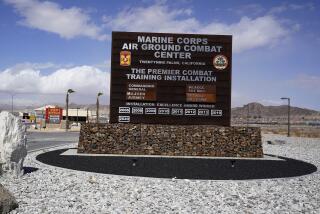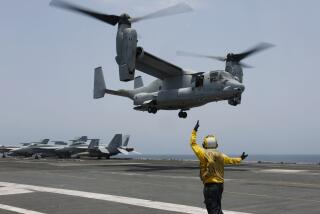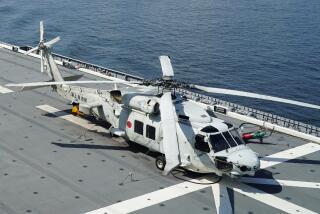Soil-Clogged Engines Blamed for Fatal Afghan Helicopter Crash
SAN DIEGO — The Marine Corps helicopter that crashed in Afghanistan last January, killing two Marines and injuring five others, lost power because its engines were clogged with powdery soil and it was flying at too high an altitude, according to a report issued here Tuesday.
The report, done by Marine Corps lawyers and helicopter commanders, praised the helicopter pilot for bravery but criticized the pilot of another helicopter for leaving the scene without landing to search for survivors.
The CH-53E Super Stallion crashed Jan. 19 in the snowy mountains near Kabul after one engine began losing power and a second engine shut down completely because of a compressor failure, the report said.
The compressor had been set at an air-intake level that was inappropriate for the high altitude where air becomes thinner. The helicopter, near its maximum load, was at about 9,000 feet when it lost power and crashed within 15 seconds.
Because the Marines were operating in a war zone without their full range of equipment, the testing apparatus that would have spotted the air-intake problem in a preflight check was not readily available.
The engine that lost power was choked with the silt-like dust that has bedeviled troops and equipment throughout the U.S. offensive in Afghanistan.
Killed instantly in the crash were Staff Sgt. Walter F. Cohee III, 26, of Mardela Springs, Md., and Staff Sgt. Dwight J. Morgan, 24, of Willits, in Northern California.
All seven crew members were assigned to a squadron known as the Flying Tigers based here at Miramar Marine Corps Air Station.
The report said the death toll would have been higher except for the quick thinking and bravery of the pilot, then-Capt. Douglas V. Glasgow.
When the three-engine helicopter lost most of its power and began falling rapidly, Glasgow was able to slow down its rate of descent and keep the helicopter from nose-diving.
After the helicopter crashed and exploded, Glasgow pulled his injured co-pilot, Capt. William J. Cody, from the burning craft and then--despite back injuries--made several trips to rescue other injured crew members while the helicopter burned and ammunition began “cooking off.”
“With complete disregard for his personal injuries and the extremely cold conditions, Capt. Glasgow continued to care for his crew and watched the area for enemy threats,” the report says.
Glasgow, a graduate of the Naval Academy and stationed at Yuma, Ariz., has since been promoted to major.
But the report criticized Capt. Alison Thompson, commander of the lead helicopter, for flying back to base after incorrectly concluding there were no survivors.
Thompson made the decision to leave after determining it was too risky to land near the rocky crash site, according to the report. The survivors were spotted by cameras in an unmanned reconnaissance aircraft and rescued by Army helicopters two hours later.
Thompson’s decision was “contrary to training” and “prolong[ed] the suffering of the mishap air crew survivors and expose[d] them to risk and capture,” according to an addendum to the report inserted by Maj. Gen. Charles F. Bolden Jr., commanding general of the 3rd Marine Aircraft Wing. A copy of the report will be sent to her superior officers.
The Marine helicopter was on a resupply mission for troops attempting to search for and destroy remaining Taliban and Al Qaeda forces.
The Super Stallions have been used extensively to move troops, food and gear to far-flung spots in Afghanistan and Pakistan.
More to Read
Sign up for Essential California
The most important California stories and recommendations in your inbox every morning.
You may occasionally receive promotional content from the Los Angeles Times.










